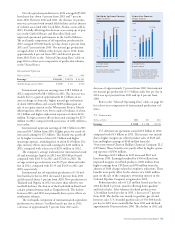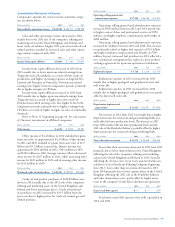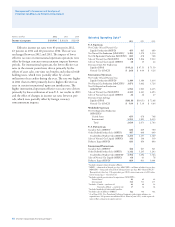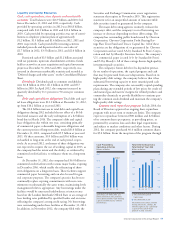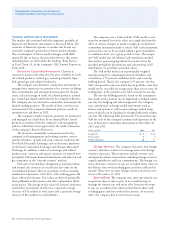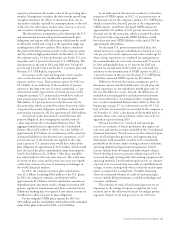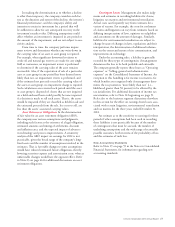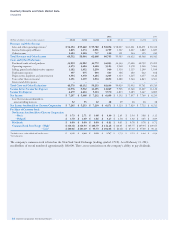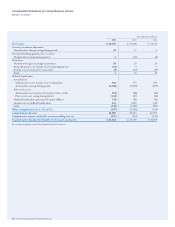Chevron 2012 Annual Report Download - page 25
Download and view the complete annual report
Please find page 25 of the 2012 Chevron annual report below. You can navigate through the pages in the report by either clicking on the pages listed below, or by using the keyword search tool below to find specific information within the annual report.
Chevron Corporation 2012 Annual Report 23
Transactions With Related Parties
Chevron enters into a number of business arrangements with
related parties, principally its equity aliates. ese arrange-
ments include long-term supply or otake agreements and
long-term purchase agreements. Refer to “Other Information”
in Note 11 of the Consolidated Financial Statements, page 47,
for further discussion. Management believes these agreements
have been negotiated on terms consistent with those that
would have been negotiated with an unrelated party.
Litigation and Other Contingencies
MTBE Information related to methyl tertiary butyl ether
(MTBE) matters is included on page 48 in Note 13 to
the Consolidated Financial Statements under the heading
“MTBE.”
Ecuador Information related to Ecuador matters is
included in Note 13 to the Consolidated Financial Statements
under the heading “Ecuador,” beginning on page 48.
Environmental e following table displays the annual
changes to the company’s before-tax environmental
remediation reserves, including those for federal Superfund
sites and analogous sites under state laws.
Millions of dollars 2012 2011 2010
Balance at January 1 $ 1,404 $ 1,507 $ 1,700
Net Additions 428 343 220
Expenditures (429) (446) (413)
Balance at December 31 $ 1,403 $ 1,404 $ 1,507
e company records asset retirement obligations when
there is a legal obligation associated with the retirement of
long-lived assets and the liability can be reasonably estimated.
ese asset retirement obligations include costs related to
environmental issues. e liability balance of approximately
$13.3 billion for asset retirement obligations at year-end 2012
related primarily to upstream properties.
For the company’s other ongoing operating assets, such as
reneries and chemicals facilities, no provisions are made for
exit or cleanup costs that may be required when such assets
reach the end of their useful lives unless a decision to sell or
otherwise abandon the facility has been made, as the inde-
terminate settlement dates for the asset retirements prevent
estimation of the fair value of the asset retirement obligation.
Refer to the discussion below for additional information
on environmental matters and their impact on Chevron, and
on the company’s 2012 environmental expenditures. Refer to
Note 22 on pages 64 through 65 for additional discussion of
environmental remediation provisions and year-end reserves.
Refer also to Note 23 on page 66 for additional discussion of
the company’s asset retirement obligations.
Suspended Wells Information related to suspended
wells is included in Note 18 to the Consolidated Financial
Statements, Accounting for Suspended Wells, beginning on
page 55.
Income Taxes Information related to income tax con-
tingencies is included on pages 51 through 53 in Note 14 and
pages 63 through 64 in Note 22 to the Consolidated Finan-
cial Statements under the heading “Income Taxes.”
e American Taxpayer Relief Act of 2012 (the Act) was
signed into U.S. law on January 2, 2013. Several tax provi-
sions that expired at the end of 2011 were extended
retroactive to January 1, 2012, including the research and
development credit and certain rules for controlled foreign
corporations. ere were no impacts from the Act included
in Chevron’s 2012 nancial statements and the company does
not expect the impacts of the Act to have a material eect on
its results of operations, consolidated nancial position or
liquidity in any future reporting period.
Other Contingencies Information related to other con-
tingencies is included on page 65 in Note 22 to the
Consolidated Financial Statements under the heading “Other
Contingencies.”
Environmental Matters
Virtually all aspects of the businesses in which the
company engages are subject to various international, fed-
eral, state and local environmental, health and safety laws,
regulations and market-based programs. ese regulatory
requirements continue to increase in both number and com-
plexity over time and govern not only the manner in which
the company conducts its operations, but also the products it
sells. Regulations intended to address concerns about green-
house gas emissions and global climate change also continue
to evolve and include those at the international or multina-
tional (such as the mechanisms under the Kyoto Protocol and
the European Union’s Emissions Trading System), national
(such as the U.S. Environmental Protection Agency’s emis-
sion standards and renewable transportation fuel content
requirements or domestic market-based programs such as
those in eect in Australia and New Zealand), and state or
regional (such as California’s Global Warming Solutions Act)
levels.
Most of the costs of complying with laws and regulations
pertaining to company operations and products are embed-
ded in the normal costs of doing business. It is not possible to
predict with certainty the amount of additional investments
in new or existing facilities or amounts of incremental oper-
ating costs to be incurred in the future to: prevent, control,
reduce or eliminate releases of hazardous materials into the
environment; comply with existing and new environmental
laws or regulations; or remediate and restore areas damaged
by prior releases of hazardous materials. Although these costs
may be signicant to the results of operations in any single
period, the company does not expect them to have a material
eect on the company’s liquidity or nancial position.
Accidental leaks and spills requiring cleanup may occur
in the ordinary course of business. In addition to the costs
for environmental protection associated with its ongoing
operations and products, the company may incur expenses
for corrective actions at various owned and previously owned
facilities and at third-party-owned waste disposal sites used
by the company. An obligation may arise when operations
are closed or sold or at non-Chevron sites where company
products have been handled or disposed of. Most of the
expenditures to fulll these obligations relate to facilities and
sites where past operations followed practices and procedures




